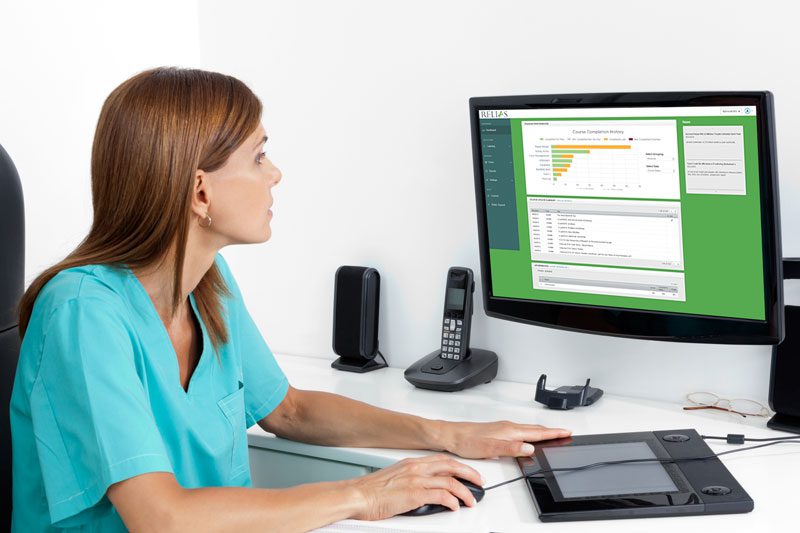Recently, thousands of employees across America have packed up their laptops, notepads, and pencils and moved out of their offices and into their homes. This has been a sudden change for many who have either been forced to work from home due to mandatory stay at home orders, or to preserve the health of those they work and live with. The decision to work from home may be difficult, but the transition doesn’t have to be.
To help contributors navigate the work from home transition, I have gathered tips from Relias employees who have been permanent remote employees for several years. Here’s what they suggest:
Set up your workspace
- Keep it clean. Your workspace has a direct impact on your headspace. If your desk is cluttered, it can be distracting. Try to clear off a space to work, even if that just means pushing your mess to the other side of the kitchen table.
- Keep it separate. Make your primary workspace somewhere you can walk away from at the end of the day. It is important to maintain a separate workspace to keep work from taking over your home and to preserve a healthy work-life balance. However, this doesn’t mean you can’t still enjoy a change of scenery. If you’re someone who likes to work in a library or coffee shop, try occasionally working in a different room or on your porch when weather permits when you need a change of pace.
- Consider what’s behind you when you turn on your camera. It’s fine to work in your bedroom, but take the time to make your bed or pick up any clothes that would be visible behind you. If you have kids, try not to pick a high traffic space where they’ll be running around you. This is distracting to you and anyone you’re trying to meet with.
Establish a regular work routine
- Get ready for work. Try to maintain your traditional morning routine, even while working from home. This could be an at home workout or run around the neighborhood to replace a morning gym session, or as simple as brewing a cup of coffee. While you may be able to sleep in by cutting out your commute, it’s still important to mentally prepare yourself before jumping into the day.
- Maintain consistent work hours. Working from home can blur the lines a bit when it comes to work-life balance. You will be tempted to be online earlier and later than you normally would if you were at the office. Try to keep the same work hours, if possible, and make sure others that are home with you are aware of those hours to minimize disturbances during the day.
- Try not to eat lunch at your desk. It’s important to give yourself a mental break. While you may feel like you’re being more productive in the moment, you may be putting yourself at risk for later burnout. Give yourself permission to walk away, and don’t be afraid to incorporate multiple breaks into your day to avoid overwhelming yourself with work.
Stay connected
- Reach out. It’s easy to become professionally lonely when you’re working from home. And now more than ever, it’s important to be available for each other and stay connected as we all navigate the challenges brought on by COVID-19. Be proactive about social interaction and maintaining an open dialogue with your colleagues that extends outside of scheduled calls.
- Embrace your video camera. Start using “video on” during all of your conference calls. It’s a way of staying connected and simulating face-to-face interaction.
- Have fun. Set up virtual sessions, including happy hours, pot lucks, and coffee breaks, with your key counterparts across your organization. Setting up fun meetings like these can give everyone something to look forward to and work toward in their day, and help the entire team reduce stress.
Finally, don’t just take my advice. Take your own advice. Think about strategies that worked for you in college when you really needed to focus on something, or advice you give your kids when they need to complete their homework. Take your team’s advice. Ask your teammates who are in similar situations how they’re navigating a transition to working remotely. Take your leader’s advice. Ask you manager for best practices for staying productive and connected even while working apart.
While this may be your first time working from home in a professional capacity, remember you may have similar experiences that can help provide guidance while navigating this new transition. You also have a wide support system within your company that you can turn to for help. As we face an uncertain period of social distancing, it’s important right now that we all support one another. So don’t be afraid to reach out. Good luck!

Maximizing Your LMS During Staffing Emergencies
From competency checks to virtual classrooms, use your learning management system (LMS) to ensure that your team members have the needed skills, training, and education to continue to provide quality patient care while reducing their time away from patients. Watch our webinar to learn more.
Watch webinar →





